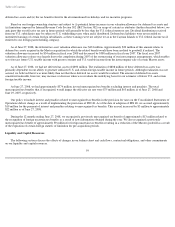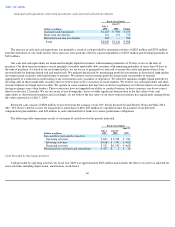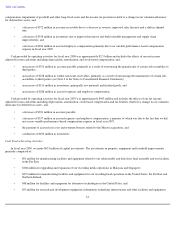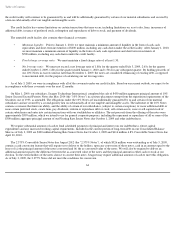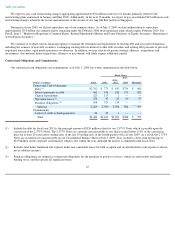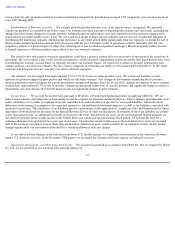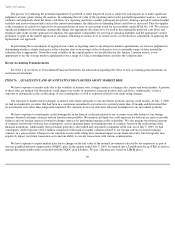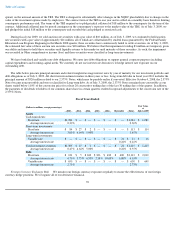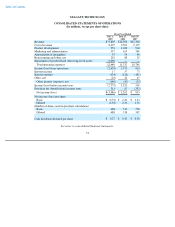Seagate 2008 Annual Report Download - page 71
Download and view the complete annual report
Please find page 71 of the 2008 Seagate annual report below. You can navigate through the pages in the report by either clicking on the pages listed below, or by using the keyword search tool below to find specific information within the annual report.
Table of Contents
The process of evaluating the potential impairment of goodwill or other long-lived assets is subjective and requires us to make significant
judgments at many points during the analysis. In estimating the fair value of the reporting units for the goodwill impairment analysis, we make
estimates and judgments about the future cash flows of a reporting unit from a market participant perspective. During a period of reduced market
visibility and increased uncertainty such as the current environment, the difficulty of estimating future cash flows is increased. This also applies
to the estimation of cash flows expected to be generated from an asset or asset group tested for recoverability under SFAS No. 144. We exercise
significant judgment in determining, among other things: the appropriate discount rate to be used in discounting the projected cash flows and
terminal value in the income approach of valuation, the appropriate comparables for arriving at valuation multiples and the appropriate control
premiums to apply in the market approach of valuation, remaining economic lives of certain assets, or obsolescence adjustments in applying the
replacement cost approach.
In performing the reconciliation of aggregate fair values of reporting units to our enterprise market capitalization, we exercise judgment in
determining whether a single stock price at the valuation date or an average of the stock prices over a reasonable range of dates around the
valuation date is appropriate. Given the recent volatility in the capital markets, we decided that for the January 2 interim review, it was
appropriate to use the average market capitalization over a range of 15 days extending before and after the valuation date.
Recent Accounting Pronouncements
See Note 1 of our Notes to Consolidated Financial Statements for information regarding the effect of new accounting pronouncements on
our financial statements.
ITEM 7A. QUALITATIVE AND QUANTITATIVE DISCLOSURES ABOUT MARKET RISK
We have exposure to market risks due to the volatility of interest rates, foreign currency exchange rates, equity and bond markets. A portion
of these risks are hedged, but fluctuations could impact our results of operations, financial position and cash flows. Additionally, we have
exposure to downgrades in the credit ratings of our counterparties as well as exposure related to our credit rating changes.
Our exposure to market risk for changes in interest rates relates primarily to our investment portfolio and our credit facility. At July 3, 2009,
we had no marketable securities that had been in a continuous unrealized loss position for a period greater than 12 months and determined that
no investments were other-than-temporarily impaired. We currently do not use derivative financial instruments in our investment portfolio.
We have exposure to counterparty credit downgrades in the form of credit risk related to our accounts receivable balances, our foreign
currency forward exchange contracts and our fixed income portfolio. We monitor and limit our credit exposure for both our accounts receivable
balances and our foreign currency forward exchange contracts by performing ongoing credit evaluations. We also manage the notional amount
of contracts entered into with any one counterparty, and we maintain limits on maximum tenor of contracts based on the credit rating of the
financial institutions. Additionally, the investment portfolio is diversified and structured to minimize credit risk. As of July 3, 2009, we had
counterparty credit exposure of $1.4 million comprised of the mark-to-market valuation related to our foreign currency forward exchange
contracts in a gain position. Changes in our corporate issuer credit ratings have minimal impact on our financial results, but downgrades may
negatively impact our future transaction costs and our ability to execute transactions with various counterparties.
We have exposure to equity market risks due to changes in the fair value of the notional investments selected by our employees as part of
our non-
qualified deferred compensation (NQDC) plan. In the quarter ended July 3, 2009, we entered into a Total Return Swap (TRS) in order to
manage the equity market risks associated with the NQDC plan liabilities. We pay a floating rate, based on LIBOR plus a
69


